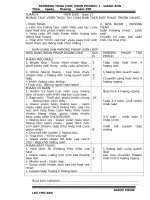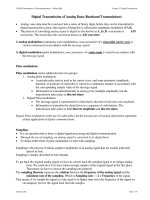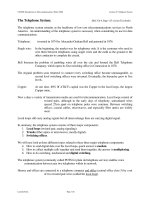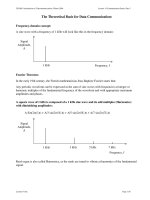Tài liệu Lecture 14: The Theoretical Basis for Data Communication: pptx
Bạn đang xem bản rút gọn của tài liệu. Xem và tải ngay bản đầy đủ của tài liệu tại đây (63.93 KB, 6 trang )
CSN200 Introduction to Telecommunications, Winter 2000 Lecture 14 Communication Basics Part-2
The Theoretical Basis for Data Communication:
Frequency-domain concept:
A sine wave with a frequency of 1 kHz will look like this in the frequency domain:
Signal
Amplitude,
A
Frequency, f
1 kHz
Fourier Theorem:
In the early 19th century, the French mathematician Jean-Baptiste Fourier states that:
Any periodic waveform can be expressed as the sum of sine waves with frequencies at integer or
harmonic multiples of the fundamental frequency of the waveform and with appropriate maximum
amplitudes and phases.
A square wave of 1 kHz is composed of a 1 kHz sine wave and its odd multiples (Harmonics)
with diminishing amplitudes:
A Sin(2π(f
1
)t) + A/3 sin(2π(3f
1
)t) + A/5 sin(2π(5f
1
)t) + A/7 sin(2π(7f
1
)t)
Signal
Amplitude,
A
3 kHz 5 kHz 7 kHz
Frequency, f
1 kHz
Reed organ is also called Harmonica, as the reeds are tuned to vibrate at harmonics of the fundamental
signal.
Lecture 14.doc Page 1 (6)
CSN200 Introduction to Telecommunications, Winter 2000 Lecture 14 Communication Basics Part-2
Addition of Frequency Components:
Lecture 14.doc Page 2 (6)
CSN200 Introduction to Telecommunications, Winter 2000 Lecture 14 Communication Basics Part-2
Addition of More Frequency Components:
Lecture 14.doc Page 3 (6)
CSN200 Introduction to Telecommunications, Winter 2000 Lecture 14 Communication Basics Part-2
Voice signal:
Voice signal is an analog signal with frequency components in the range of 20Hz to 20kHz:
Signal
Amplitude,
A
Time, t
Voice signal
Signal
Amplitude,
A
Frequency, f
1 kHz 3 kHz
Spectrum, of a signal is the range of frequencies that it contains. The intelligent voice signal spectrum
extends from 300 Hz to 3400 Hz.
Bandwidth, of a signal is the width of the spectrum. The bandwidth of the intelligent voice signal is
3100 Hz
Telephone equipment allows the voice a bandwidth of 4000Hz, which includes a guard band at top
(600Hz) and bottom (300Hz) to prevent interference. This limit on bandwidth is imposed by the
telephone and the switching equipment used in the telephone network.
Video signal:
Video signal is an analog signal with frequency components in the range of 60 Hz to 4 MHz.
The bandwidth is almost 4 MHz. With guard bands the standard bandwidth for colour video signaling
is 6 MHz.
Signal Bandwidth
Telephone speech 3.1 kHz
Hi-fi stereo 20 kHz
AM radio station 10 kHz
FM radio station 200 kHz
TV station 6 MHz
Lecture 14.doc Page 4 (6)
CSN200 Introduction to Telecommunications, Winter 2000 Lecture 14 Communication Basics Part-2
Digital Data Signal:
Bit rate, is the number of bits transmitted per second.
Baud rate, is the signaling speed. That is the number of times the signal changes its value , e.g., voltage
per second.
In case of digital transmission through the transmission line similar to telephone line of bandwidth 3.1
kHz the maximum bits can be transmitted is 3.1 kHz x 2 = 6.2 kbps.
But in practice we transmit through the telephone lines either tones (1200Hz) of different amplitude or
two different tones (1200Hz & 2400Hz) to represent 0 and 1 per unit time of the signal. So, the
maximum bit rate is the same as the signal rate, 3.1 kbps.
To increase the bit rate different coding scheme has been implemented over time. That is 2, 4, 8 and 16
bits has been transmitted per signal unit. So, the baud rate and the bit rate are no longer the same.
Power in Telecommunications and Decibels:
Power is the amount of energy per unit time and is unit is Watts.
1 W of electricity is equal to 1 A of electricity flowing through 1 Ohm of resistance.
P = I
2
R
If current is doubled, the power goes up by a factor of 4.
In telecommunications, we deal with extremely low power levels such as 10 thousandth of a watt (10
mW).
The milliwatt is the unit of measure used for power in telecommunications circuits.
Rather than absolute measure of power, we often concerned with the comparison of one power level to
another.
Such as the output power of an amplifier (RF or AF) is 1000 mW for an input power of 10 mW.
We can say this whole this output with one unit, such as the output is 20dB.
The relative power of output to input will tell us the gain of the amplifier, P
o
/P
I
= 1000mW/10mW
= 100.
The unit of measure used to compare two power levels is the decibel (dB).
A decibel is not an absolute measurement. It is a relative measurement. The decibel level indicates the
relationship of one power level to another.
The formula for calculating decibel is :
dB = 10 log P
o
/P
i
= 10 log 1000mW/10mW
= 10 log 100
= 10 x 2
=20
dB tells us the ratio of two power levels, that is it expresses the gain of the system.
But some time we want to express the exact output power of a system rather than the gain.
In that case, we compare the power levels with a known reference, such as 1mW.
So, the output power will be 30 dBm (10 log 1000mW/1mW = 10 x log 1000 = 10 x 3).
Notice the addition of a small "m" after the "dB", that says the reference is 1 mW.
Decibels referenced to 1 mW provides a convenient measure for measuring the signal levels in
Lecture 14.doc Page 5 (6)









